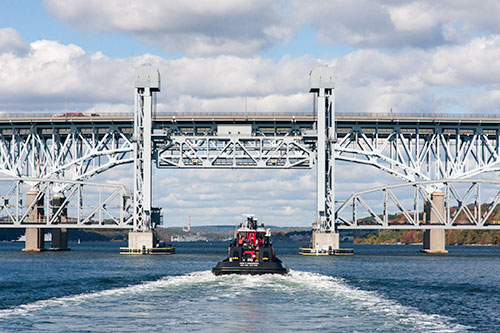
STATE SENATOR
Cathy Osten
DEPUTY PRESIDENT PRO TEMPORE
GETTING RESULTS
- Representing
- Columbia,
- Franklin,
- Hebron,
- Lebanon,
- Ledyard,
- Lisbon,
- Marlborough,
- Montville,
- Norwich,
- Sprague

GROTON—Declaring that the largest and longest bridge in Connecticut—the Gold Star Memorial Bridge—is a commuter necessity, a tourism priority, and essential to national security and the health of the regional economy, a group of Democratic lawmakers today urged Governor Ned Lamont and the state Department of Transportation to make renovations to the bridge a financial and public policy priority—and to implement tolls in Connecticut in order to help pay for it.
State Senator Cathy Osten (D-Sprague) and state Representatives Christine Conley (D-Groton) and Joe de la Cruz (D-Groton) issued their appeal today, the same day Gov. Lamont visited the Gold Star Memorial Bridge to make his case for tolls to help pay for Connecticut’s massive and long-overdue transportation infrastructure needs.
“Repairing Connecticut’s transportation infrastructure of bridges and roads can no longer be separated from the issue of instituting tolls. If we are serious about business and job growth in this state, and if we are serious about the safety of our daily commuters, we will pass a comprehensive tolls bill this session and we will use some of that future revenue to repair the Gold Star Memorial Bridge, which is in dire need of upgrades,” Sen. Osten said. “It’s time we joined the rest of the East Coast of America in creating a long-term, sustainable and fair revenue source for Connecticut’s needs, a user fee which asks out-of-state drivers to pay for the privilege of driving on our highways, like we have to pay everyone else. Let’s get ours.”
“I am very pleased that the governor and DOT recognize how important this bridge is to southeastern Connecticut,” said Rep. Conley. “Repairs to the Gold Star are imperative to ensure that this economic engine is preserved, but also that the structure is up to code for everyone who uses the bridge either daily or occasionally. This is great news for all of Connecticut.”
“The bridge is vital for commuters and commercial traffic, and especially for our manufacturers like Electric Boat,” said Rep. de la Cruz. “Making sure the Gold Star is able to serve the area, safely and efficiently, is critical, and I applaud the governor and DOT for their efforts in completing this long-overdue project.”
At more than a mile long, 155 feet high, and with a million square feet of surface area over a dozen travel lanes, the Gold Star Memorial Bridge is the largest bridge in Connecticut; it transports more than 42 million cars and trucks over the Thames River every year, crossing from New London to Groton. It was built in 1943 and is now three-quarters of a century old.
While the southbound lanes of the Gold Star Memorial Bridge were recently resurfaced, a much larger, much more expensive and much more complicated renovation of the northbound lanes awaits Connecticut commuters.
The DOT says the bridge is “is in need of significant rehabilitation” and estimates that strengthening steel trusses and truss bearings, repairing concrete piers, strengthening and replacing steel girders and girder bearings, replacing the bridge deck and parapet, repairing storm drains and replacing navigational beacons will cost at least a quarter-billion dollars and take six years to accomplish.
Due to those concerns, the northbound lanes of the Gold Star Memorial Bridge are currently “load-restricted” by the DOT, requiring 400-500 truckloads every year (some carrying submarine equipment for General Dynamics Electric Boat) to make a 30-mile detour.
The DOT has proposed a two-phase construction plan for the northbound lanes, with work on Phase One beginning in May 2020 and Phase Two ending sometime in 2025.
Share this page: